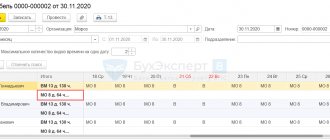Legal regulation
The concept of “shift work” is given in Art. 103 of the Labor Code of the Russian Federation. It also stipulates the principles for developing and coordinating shift schedules.
Art. 104 of the Labor Code of the Russian Federation allows the introduction of summarized accounting of working hours if it is impossible to organize a daily or weekly norm for subordinates.
It also stipulates the duration of the accounting period and the employer’s ability to determine this duration for his organization.
The Labor Code does not provide a clear concept of deficiency.
But according to Art. 102 of the Labor Code of the Russian Federation, it is the employer who is obliged to ensure full working hours during the accounting period for each worker.
In accordance with Art. 91 of the Labor Code of the Russian Federation, he is also obliged to keep a count of the time actually worked by each employee.
Art. 155 of the Labor Code of the Russian Federation regulates the amount of payments for failure to comply with labor standards due to the fault of one of the parties or for reasons that could not be influenced by either the manager or the subordinate.
Shortcomings in the shift schedule due to the fault of the employee
If the employee is to blame for the shortfall, then he will not be paid for these hours. In this case, the calculation will be made based on the amount of time worked. If the salary is calculated based on the tariff rate, then the tariff rate is multiplied by the hours worked by the employee.
If the calculation is made based on the official salary, then the tariff rate is also calculated. In this case, the calculation can be made in different ways. The employer independently chooses the most suitable one for himself. When calculating, the amount of the tariff rate is obtained, which is then multiplied by the number of hours worked by the employee.
Procedure for recording time worked
Often, the usual 40-hour work week, consisting of five 8-hour working days, is not suitable for the most productive use of production capacity or increasing the quantity of output.
If such a difficulty arises, management has the right to introduce a shift work schedule, in which it is allowed to increase the amount of permissible working time.
Each shift of workers performs their job duties in accordance with the shift schedule, which stipulates the duration of working hours.
Production calendar and shift schedules
The most common types of charts are:
- two-shift;
- three-shift;
- “in three days” (a working day is replaced by three days of rest);
- for four shifts (3 shifts work daily, each at its own hours, and the fourth shift has a day off).
Shift schedules are developed by the employer. They must be consistent with the trade union, if it exists in the organization.
The number of working hours in such a schedule must correspond to their number in the production calendar.
Shift schedules reflect the duration of work on each shift, as well as rest time.
According to the law, the work of each employee working two shifts in a row is prohibited.
The management introduces the shift schedules to subordinates against signature at least a month before their introduction.
If the employer, by internal regulation, has introduced a shift work schedule at the enterprise, it will be more effective to calculate the time worked using a summarized accounting system.
With it, the reporting period is assigned to a time period of more than a week, but not more than a year.
The management of the enterprise can choose the duration of the reporting period in the amount of a month, quarter, half year or year, which must be reflected in internal regulations.
Within this selected reporting period, each employee working on a shift schedule produces an unequal number of working hours. It is also possible that the number of shifts per week may not be the same.
But in general, for the entire reporting period, the employee must work the number of working hours legally established for this category of workers.
Shift schedules must be drawn up so that excess working hours in some shifts are compensated by additional days off or shortened shifts throughout the reporting period.
The longer the reporting period, the easier it is for management to balance over- and under-working hours.
Despite the flexibility of the summary accounting system, at the end of the accounting period, when calculating working hours, so-called overwork or shortcomings may be detected. The situation of the deficiency will be discussed further.
What is taken into account and what is not when calculating working hours
In addition to working hours in shifts, work activities in conditions deviating from normal are subject to calculation.
According to Art. 149 of the Labor Code of the Russian Federation, this concept includes overtime work, work at night (from 22.00 to 6.00), on weekends and non-working holidays.
When performing official duties under the above circumstances, an employee can count on appropriate additional payments.
When calculating working time, working hours when the employee did not perform his job duties are not taken into account, but he retained his position (including all types of vacations) and time spent on business trips.
Also, the hour of reduction in working hours on holidays is not taken into account.
Working time calculation
In addition to the number of working hours in a shift, the employer must also take into account the work activities of employees that deviate from the norm. In accordance with Art. 149 of the Labor Code of the Russian Federation, this concept includes overtime work, night work, as well as work on weekends and holidays. If an employee works in these circumstances, then the employee has the right to count on additional payments. When calculating working hours, those working hours during which the employee did not work, but his position was retained (including all types of vacations, as well as business trip time), are not taken into account. In addition, the hour by which working hours are reduced before the holiday weekend is also not taken into account.
Reasons for defects
For further correct calculation of additional payments for hours of shortcomings, it is especially important to establish the reasons for their occurrence.
They are as follows:
- Due to the employee's fault. Deficiencies discovered at the end of the reporting period may arise due to the employee’s absence from the workplace for valid reasons. This refers to all types of leave - annual, educational, unpaid (“leave at your own expense”), sick leave. There are also disrespectful reasons, namely absenteeism and downtime due to the fault of the worker.
- Due to management's fault. A change in the work schedule that resulted in shortcomings is the fault of the enterprise management. This also includes the initially incorrect drawing up of a schedule, which does not allow the employee to work out the required working hours during the reporting period.
- Due to circumstances beyond the control of the employee and employer. Defects also arise as a result of various force majeure situations, be it natural or man-made disasters, as well as the development of new equipment or technology by employees.
How does underemployment affect wages?
Shortages are possible under any labor regime if the contract specifies the above-mentioned norm that the employee must work for a certain period in order to receive the agreed salary. The employer, in turn, is obliged to ensure that the required amount of time is worked during the accounting period. Thus, the question is about receiving a full salary.
It is logical that a specialist who works less receives, accordingly, less income. However, this only happens if the standard is not achieved due to the fault of the employee.
If the employer has not fulfilled his obligation to provide the employee with the required amount of working time (for example, he incorrectly drew up a work schedule or was unable to quickly fix equipment breakdowns), the citizen must receive a salary of no less than the average.
If neither party is at fault, the employee receives at least two-thirds of the tariff rate or salary.
Methods of remuneration when identifying a shortage of working hours
If the enterprise keeps a summary calculation of working hours, the monthly salary is calculated in one of two ways:
- Hourly rate applies. In this case, the payment to the employee at the end of the month is calculated by multiplying the rate by the number of hours actually worked.
- The official salary is established, and the employee is paid the same amount of money every month (subject to the full completion of the norm of working hours specified in the shift schedule).
The fact of shortfall (shortage of hours actually worked in relation to the norm) is revealed only at the end of the reporting period, when the total amount of time worked for each employee is calculated.
When deciding whether or not to accrue additional payments to an employee, the reasons for each case of deficiency, which were discussed earlier, are of significant importance.
Due to the employee's fault
If an employee is to blame for the identified shortfall in work hours, these hours will not be paid in any way.
The basis for calculations will be the actual time worked.
- If an employee’s salary is calculated based on an hourly rate, it is necessary to multiply the amount of the rate by the working hours worked.
- If the official salary is established, you should, based on it, calculate the same hourly tariff rate. There are several methods for calculating it, and the management of the enterprise has the right to choose the most suitable one. The resulting final wage rate based on salary is multiplied by the actual number of hours worked.
Due to the employer's fault
As stated earlier, the employer is required by law to provide the employee with the opportunity to work the standard working hours in full during the reporting period.
If this does not happen, the employee has the right to count on additional payment for unworked time.
Payment is made in an amount not lower than the average salary, calculated in proportion to the hours worked.
The average salary, in turn, is calculated by multiplying the number of unworked hours by the average hourly earnings.
For other reasons
If the occurrence of a defect is not the fault of the worker or management, the wage is an amount not lower than 2/3 of the tariff rate or official salary, calculated in proportion to the time actually worked.
- If an employee’s salary is calculated at an hourly rate, it is necessary to multiply 2/3 of it by the hours of shortfall.
- When an employee works for an official salary, after calculating the hourly tariff rate, 2/3 of it should be multiplied by the amount of unworked time.
Each case of a defect must be carefully studied by the management of the enterprise to clearly understand the reason for its occurrence.
The procedure for calculating wages, as well as possible further contacts on this issue with the labor inspectorate, depend on the cause of the deficiency.
The most difficult issues in summarizing working time recording will be discussed in the video.
Payment procedure for shortcomings in the shift schedule
If a company calculates time summarily, then wages are calculated in one of the following ways:
- Using an hourly rate. With this method, the employee is paid a salary based on the results of the month by multiplying the established rate by the number of hours worked.
- By establishing the official salary. The employee is set an official salary and if he fulfills the norm established in the schedule, the employee is paid the full salary.
Failure by an employee to complete the number of hours in accordance with the established norm is revealed only at the end of the reporting period, when the employer calculates the number of hours worked by each employee.
Important! Before deciding whether to accrue additional payment to an employee, or the lack thereof, the reasons for the shortfall will be important.
How is the standard working time calculated for the reporting period?
The rules for calculating working time standards for reporting periods of different lengths are established by order of the Ministry of Health and Social Development of Russia dated August 13, 2009 No. 588n. In accordance with this document, the calculation of the standard time for working activities is carried out as follows:
- The length of the working week established for the employee (40, 39, 36, etc. hours) is first divided by 5, then multiplied by the number of days of work according to the calendar based on the 5-day working week of the month in question. Thus, with an employee’s standard of 40 hours per week, the standard for October 2021 will be 40 / 5 × 21 = 168 hours.
- From the result obtained, it is necessary to subtract the number of hours by which pre-holiday days are reduced, if there are any in the desired month.
By analogy, the standard labor time is calculated for any other accounting period (quarter, half-year, year). As a result, if the company has established a summarized accounting of time worked and a quarter is selected as the reporting period, the standard working time for a 40-hour work week for the 3rd quarter of 2021 will be:
- July - 184 hours;
- August - 168 hours;
- September - 176 hours.
That is, in order to develop a standard according to the schedule for the 3rd quarter of 2021, the worker must ultimately work 528 hours.








